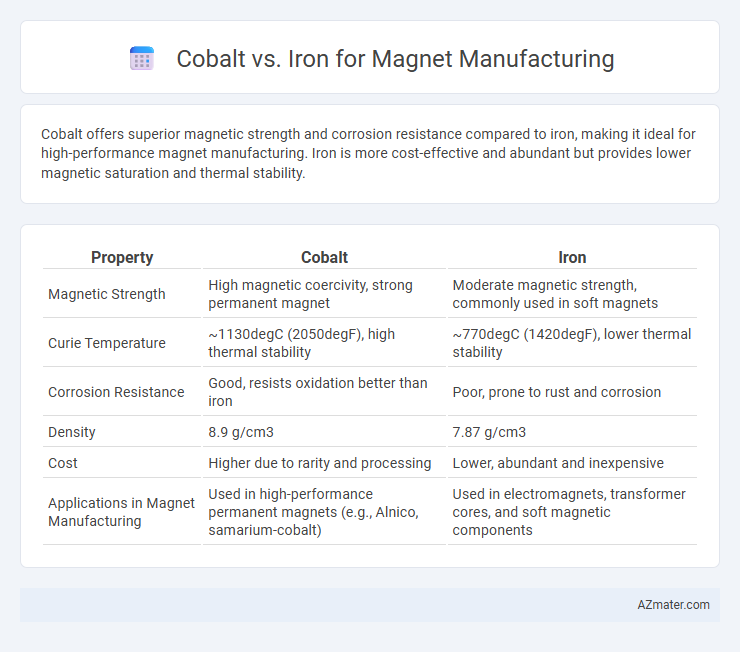Cobalt offers superior magnetic strength and corrosion resistance compared to iron, making it ideal for high-performance magnet manufacturing. Iron is more cost-effective and abundant but provides lower magnetic saturation and thermal stability.
Table of Comparison
| Property | Cobalt | Iron |
|---|---|---|
| Magnetic Strength | High magnetic coercivity, strong permanent magnet | Moderate magnetic strength, commonly used in soft magnets |
| Curie Temperature | ~1130degC (2050degF), high thermal stability | ~770degC (1420degF), lower thermal stability |
| Corrosion Resistance | Good, resists oxidation better than iron | Poor, prone to rust and corrosion |
| Density | 8.9 g/cm3 | 7.87 g/cm3 |
| Cost | Higher due to rarity and processing | Lower, abundant and inexpensive |
| Applications in Magnet Manufacturing | Used in high-performance permanent magnets (e.g., Alnico, samarium-cobalt) | Used in electromagnets, transformer cores, and soft magnetic components |
Overview: Cobalt vs Iron in Magnet Manufacturing
Cobalt and iron are critical metals in magnet manufacturing, with cobalt offering superior corrosion resistance and thermal stability compared to iron. Iron is extensively used due to its high magnetic saturation and cost-effectiveness, forming the basis of traditional magnets like ferrites and alnico alloys. Cobalt enhances magnet performance in high-temperature applications, often alloyed with other elements to produce rare-earth magnets such as samarium-cobalt, which exhibit exceptional coercivity and energy product.
Magnetic Properties Comparison
Cobalt offers higher magnetic saturation and better temperature stability compared to iron, making it ideal for high-performance magnet manufacturing. Iron, while possessing strong magnetic permeability and low coercivity, tends to lose magnetization at elevated temperatures more quickly than cobalt. The superior Curie temperature of cobalt (around 1,115degC) compared to iron (770degC) enables magnets made from cobalt alloys to maintain stable magnetic properties under demanding thermal conditions.
Raw Material Availability and Cost
Cobalt, essential for high-performance magnets like samarium-cobalt, faces limited raw material availability due to its concentration in geopolitically sensitive regions, driving up extraction and refinement costs. Iron, abundant and widely distributed globally, offers a cost-effective raw material basis for magnets such as ferrite and alnico, ensuring stable supply chains and lower production expenses. The scarcity and higher price volatility of cobalt contrast sharply with iron's affordability and accessibility, significantly impacting the economic feasibility of magnet manufacturing.
Durability and Corrosion Resistance
Cobalt alloys exhibit superior durability and corrosion resistance compared to iron, making them ideal for high-performance magnet manufacturing. Cobalt magnets maintain magnetic properties under extreme temperatures and harsh environments, while iron magnets often suffer from oxidation and structural degradation over time. The enhanced corrosion resistance of cobalt reduces maintenance needs and extends the lifespan of magnetic components in industrial applications.
Temperature Stability and Performance
Cobalt offers superior temperature stability compared to iron in magnet manufacturing, maintaining magnetic performance at elevated temperatures up to 1000degC, whereas iron-based magnets typically degrade above 500degC. The high Curie temperature of cobalt (approximately 1,115degC) ensures consistent magnetic strength, making cobalt magnets ideal for high-temperature applications like aerospace and electric motors. In contrast, iron magnets provide higher magnetic saturation at room temperature but are less reliable in extreme thermal environments due to rapid loss of magnetization.
Applications in Industry: Cobalt vs Iron Magnets
Cobalt magnets, primarily made from samarium-cobalt alloys, exhibit high temperature resistance and excellent corrosion stability, making them ideal for aerospace and military applications where precision and longevity are critical. Iron-based magnets, such as ferrite or alnico types, offer cost-effective solutions with strong magnetic strength, widely used in electric motors, transformers, and industrial machinery. The choice between cobalt and iron magnets depends on specific industry requirements for thermal stability, magnetic performance, and budget constraints.
Environmental Impact and Sustainability
Cobalt mining has a higher environmental impact due to toxic chemical usage and significant water pollution, while iron ore extraction generally involves lower ecological disruption and more abundant reserves. Iron-based magnets, such as those using neodymium-iron-boron alloys, offer greater sustainability by relying on more widely available materials with established recycling processes. Sustainable magnet manufacturing increasingly favors iron over cobalt to reduce carbon footprint, mitigate resource scarcity, and promote circular economy practices.
Processability and Manufacturing Techniques
Cobalt offers superior processability in magnet manufacturing due to its higher melting point and greater resistance to oxidation, allowing for more precise sintering and heat treatment processes compared to iron. Iron magnets require specialized coatings and controlled atmospheres during fabrication to prevent corrosion, complicating manufacturing techniques. Advanced methods like powder metallurgy and hot isostatic pressing are more effectively applied to cobalt-based magnets, enhancing magnetic performance and structural integrity.
Lifespan and Maintenance Requirements
Cobalt-based magnets exhibit a longer lifespan due to their superior corrosion resistance and thermal stability compared to iron magnets, which are more prone to oxidation and wear over time. The maintenance requirements for cobalt magnets are lower as they maintain magnetic properties under harsh environmental conditions without frequent reconditioning. Iron magnets demand regular maintenance to prevent rust and magnetic degradation, increasing long-term operational costs.
Future Trends and Innovations in Magnet Materials
Cobalt-based magnets, particularly samarium-cobalt alloys, offer superior temperature stability and corrosion resistance compared to iron-based magnets, making them ideal for high-performance applications and driving innovation in electric motors and aerospace technologies. Emerging trends focus on optimizing cobalt-iron composite materials to balance cost-efficiency with magnetic strength, enabling broader use in renewable energy systems and next-generation electronic devices. Research into nanostructured cobalt-iron alloys and rare-earth-free magnets is accelerating, aiming to enhance magnetic properties while reducing reliance on critical elements, shaping the future of sustainable magnet manufacturing.

Infographic: Cobalt vs Iron for Magnet manufacturing
 azmater.com
azmater.com